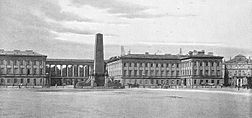Pałac Saski
| Saxon Palace Pałac Saski (in Polish) |
|
|---|---|

Saxon Palace, ca. 1890
|
|
| General information | |
| Architectural style | Neoclassical (1838) |
| Town or city | Warsaw |
| Country | Poland |
| Construction started | 1666 |
| Demolished | 1944 |
| Design and construction | |
| Architect | Adam Idźkowski (1838) |
The Saxon Palace (Polish: pałac Saski w Warszawie) was one of the most distinctive buildings in prewar Warsaw, Poland. It is planned to reconstruct the building.
The Saxon Palace had been preceded by a manor house belonging to . After 1661 his brother and heir Jan Andrzej Morsztyn had replaced the manor house with a baroque palace (Pałac Morsztynów, "the Morsztyn Palace") with four towers.
In 1713 the Morsztyn Palace was purchased by the first of Poland's two Saxon kings, Augustus II (reigned in Poland 1697–1706 and 1709–33), who began enlarging it. In 1748 the palace's rebuilding was completed by his son, King Augustus III.
In the early 19th century, the Saxon Palace housed the Warsaw Lyceum in which Frédéric Chopin's father Nicolas Chopin taught French, living with his family on the palace grounds.
The Palace was remodeled in 1842.
After World War I, the Saxon Palace was the seat of the Polish General Staff. In 1925, the Tomb of the Unknown Soldier was established within the colonnade-topped arcade that joined the Palace's two symmetric wings.
The Palace continued to be sandwiched between the Saxon Garden, to its rear, and the Saxon Square in front (which would be renamed Piłsudski Square after the Marshal's death in 1935).
...
Wikipedia
